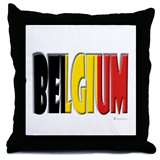Sponsored Links
Belgium: 20 Basic information

1. OFFICIALLY THE KINGDOM OF BELGIUM, Belgium is a state in Western Europe which covers an area of 30,528 square kilometres, having an estimated population of 10.8 million people.
2. Belgium is famous for seafood (such as mussels), chocolate, some 300 varieties of beer, waffles, and frites (fried potatoes)—which Belgians claim to have invented and which are sometimes served with mayonnaise.
3. The Belgian chemical industry leads the world in the production of cobalt and radium salts and also ranks high in the production of fertilizers and plastics.
4. Belgium is a founding member of the powerful North Atlantic Treaty Organization (NATO), a defense alliance created to enhance the stability, well-being, and freedom of its members (e.g. United Kingdom, United States, Canada, Germany, France, Italy, etc.). NATO’s headquarters are found in Brussels, Belgium.
5. It is a founding member of the European Union and hosts the EU's headquarters. The monetary unit of Belgium is the single currency of the European Union (EU), the euro.
6. The name 'Belgium' is derived from Gallia Belgica, a Roman province in the northernmost part of Gaul that, before Roman invasion in 100 BC, was inhabited by the Belgae, a mix of Celtic and Germanic peoples. From the end of the Middle Ages until the 17th century, it was a prosperous centre of commerce and culture.
7. Belgium is also called the battleground of Europe as many battles between European powers were fought in its area. This was the theatre of most Franco-Spanish and Franco-Austrian wars during the 17th and 18th centuries. Belgian Revolution erupted in 1830 when Belgium seceded from the Netherlands.
8. The opening months of the World War I (1914) were known as the Rape of Belgium. Germany invaded Belgium as part of the Schlieffen Plan (Germany’s plan to swing through Belgium, move southward to engulf Paris). Much of the Western Front fighting of the war occurred in western parts of Belgium.
9. During the course of the 20th century, Belgium possessed a number of colonies in Africa (e.g. Congo).
10. Belgium is a constitutional monarchy and parliamentary democracy. Executive power is vested in the king, who appoints the prime minister, cabinet ministers, and judges. The king is commander in chief of the armed forces and, with the approval of parliament, has the power to declare war and conclude treaties. The rights of the king, according to the constitution, include convening and dissolving parliament, conferring titles of nobility, and granting pardons. All royal acts, however, must be countersigned by a minister, who in turn assumes responsibility for those acts before parliament.
11. Belgium is home to two main linguistic groups, the Dutch-speakers, mostly Flemish, and the French-speakers, mostly Walloons, plus a small group of German-speakers. Belgium's two largest regions are the Dutch-speaking region of Flanders in the north and the French-speaking southern region of Wallonia.
12. Belgium has three official languages: Dutch, French and German. An estimated 59% of the Belgian population speaks Dutch (often colloquially referred to as "Flemish"), and French is spoken by 40% of the population.
13. Almost all of the Belgian population is urban—97% in 2004. The population density of Belgium is 342 per square kilometre (886 per square mile). The most densely inhabited area is Flanders, and in particular the Flemish Diamond, outlined by the Antwerp–Leuven–Brussels–Ghent agglomerations.
14. Belgium’s major contribution to fundamental science was due to a Belgian cosmologist, Georges Lemaître (Catholic University of Leuven), who is credited with proposing the Big Bang theory of the origin of the universe in 1927.
15. Other famous Belgians are Albert Claude, the first biochemist to isolate a cancer cell; Eddy Merckx, five times winner of the Tour de France; and Adolphe Sax, inventor of the saxophone.
16. Festivals play an important part in Belgian life. One of the most famous is the three-day celebration of Carnival at Binche, near Mons, held just before Lent. During Carnival, noisemaking and dancing are led by Gilles, men dressed in high, plumed hats and bright costumes.
17. Roman Catholicism has traditionally been Belgium's majority religion. During the reign of Albert I and Baudouin, the monarchy has had a reputation of deeply rooted Catholicism. However, by 2009 Sunday church attendance was 5.4 % in Flanders compared to 12.7 % in 1998. (Sunday church attendance was 11.2% for the total of Belgium in 1998.)
18. Long marriage engagements are common, as is living together before or instead of marriage. Only civil marriages are legal, but many couples also have a religious ceremony.
19. The Congregatio Immaculati Cordis Mariae, or the Congregation of the Immaculate Heart of Mary (CICM) is a Belgian Roman Catholic missionary congregation established in 1862 by the priest Théophile Verbist. Its origins lie in Scheut, Anderlecht, a suburb of Brussels. The congregation did missionary work in China, Mongolia, Democratic Republic of the Congo, and the Philippines.
20. Saint Louis University, an educational institution in Baguio City, Philippines, was founded in 1911 by the Belgian order Congregatio Immaculati Cordis Mariae. In 1907, the CICM Missionaries arrived in the Philippines as mandated by the Vatican. In 1911, Rev. Fr. Séraphin Devesse, CICM, founded a one-room elementary school in Baguio for ten local boys, naming the school the Saint Louis School.
References:
Wikipedia
Microsoft Encarta 2006
Encarta Dictionary
How to cite this article:
Bro. Jensen dG. Mañebog & Atty. John Labsky Maximo. “Belgium: 20 Basic information” @ www.OurHappySchool.com
Related articles:




